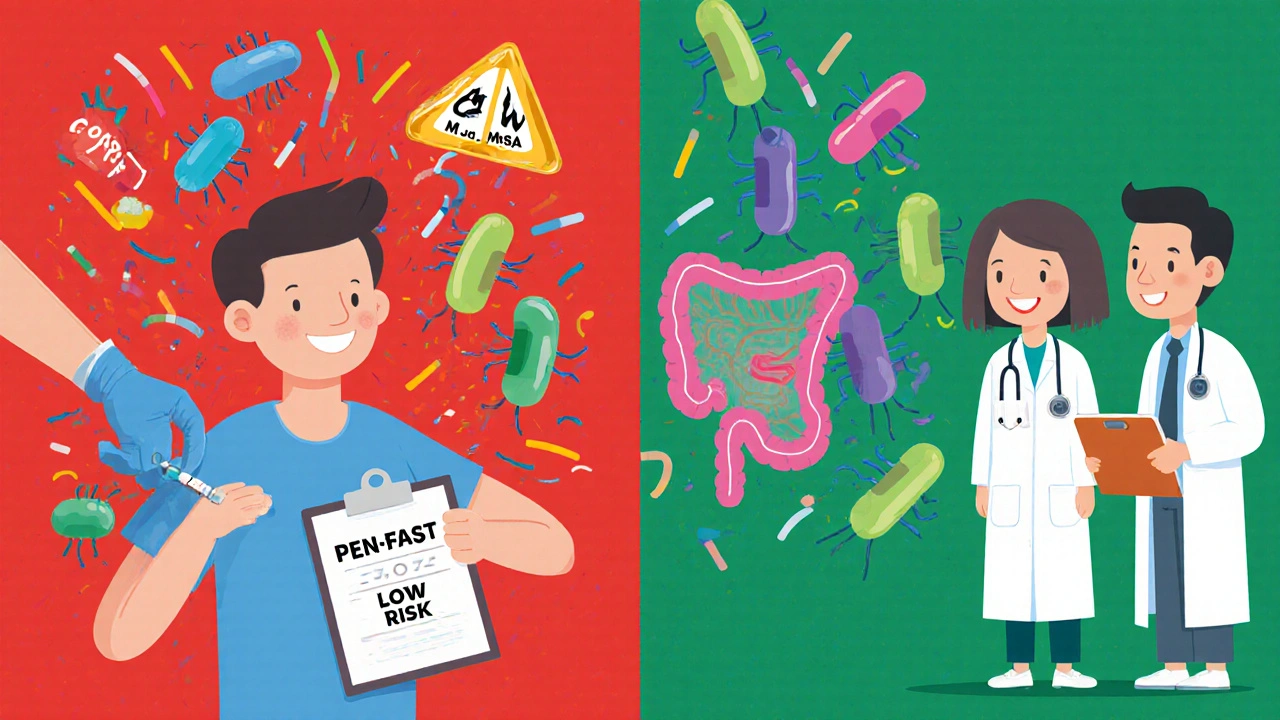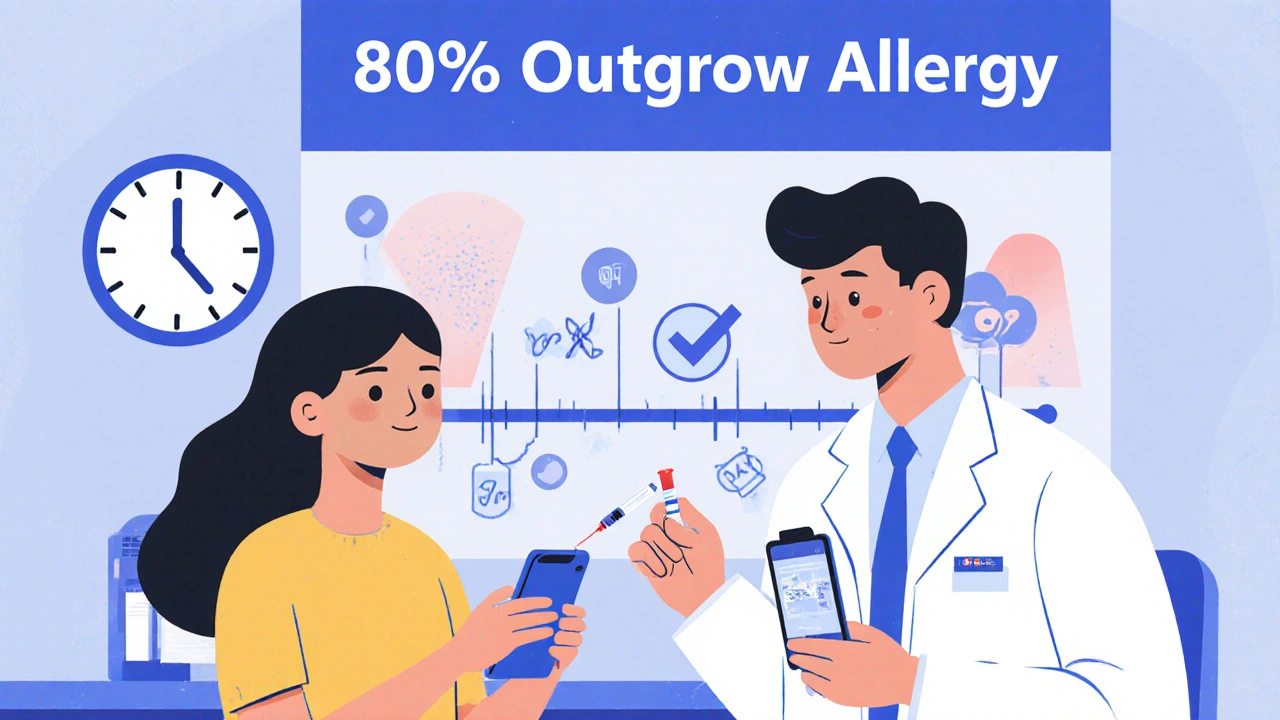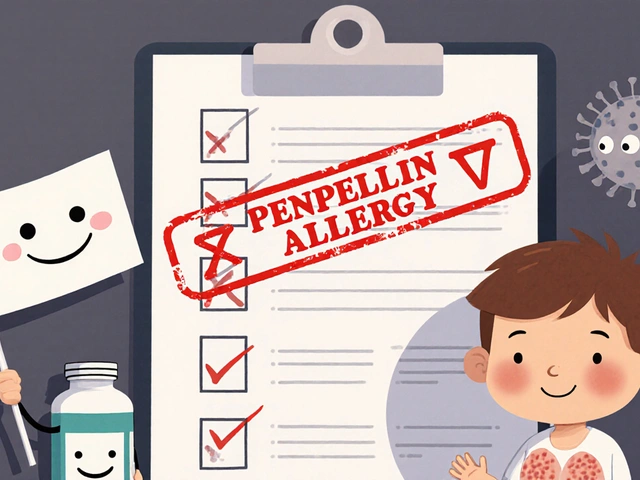Penicillin Allergy Risk Checker
Assess Your Reaction Risk
This tool helps determine if your past penicillin reaction was likely a true allergy or side effect. Based on CDC/PEN-FAST criteria.
Your Risk Assessment
Next Steps
- - If high risk: Consult an allergist immediately
- - If low/moderate risk: Consider penicillin allergy testing
More than 10% of people in the U.S. say they’re allergic to penicillin. But here’s the truth: penicillin allergy is often misdiagnosed. Most of those people aren’t truly allergic-they just had a side effect. And that mistake is costing lives, money, and effective treatment.
What’s Really Going On With Penicillin Allergies?
Penicillin was discovered in 1928, and by World War II, it was saving lives on a massive scale. Today, it’s still one of the most common antibiotics used. But if your chart says "penicillin allergy," you’re probably being treated with something stronger, more expensive, and riskier than you need to be. The problem? People confuse side effects with true allergies. A rash after taking penicillin? That doesn’t always mean your immune system is attacking the drug. It could be a virus, a harmless reaction, or even a coincidence. But once it’s written in your medical record, it sticks-often for life. According to the CDC, only about 1% of people who say they’re allergic to penicillin actually have a true IgE-mediated allergy. That means 9 out of 10 people labeled allergic can probably take penicillin safely. Yet, they’re still avoiding it.True Allergy vs. Side Effect: The Key Differences
Understanding the difference isn’t just academic-it changes your treatment. Here’s how to tell them apart.True Penicillin Allergy: Immune System Reaction
A true allergy involves your immune system. It’s not just discomfort-it’s a biological response that can be life-threatening. These reactions are usually immediate, happening within minutes to an hour after taking the drug. Symptoms include:- Hives (raised, itchy red welts)
- Swelling of the lips, tongue, or throat
- Wheezing or trouble breathing
- Dropping blood pressure
- Anaphylaxis (a full-body emergency reaction)
Side Effects: Common, Not Allergic
Side effects are the body’s normal, non-immune response to a drug. They’re uncomfortable, but not dangerous in the way an allergy is. And they’re far more common. Typical penicillin side effects include:- Mild nausea or stomach upset (affects 5-10% of users)
- Diarrhea (1-2% of users)
- Vaginal yeast infections
- Headache or dizziness
- A flat, red rash that appears days after starting the drug
Why This Mistake Is So Dangerous
When doctors avoid penicillin because of a mislabeled allergy, they reach for other antibiotics. And those alternatives come with serious downsides.- Patients with false penicillin labels are 70% more likely to get broader-spectrum antibiotics like vancomycin or clindamycin.
- These drugs increase the risk of C. diff infection-from 5.5 to 12.5 cases per 1,000 patient days.
- They also raise the chance of MRSA colonization.
- Each unnecessary hospital stay due to mislabeled allergy costs about $1,000 more.
- Patients with false allergy labels have a 6 in 1,000 higher risk of dying within a year after hospitalization.

How to Find Out If You’re Really Allergic
If you were told you’re allergic to penicillin as a child-or even as an adult-and you’ve never been tested, you should get evaluated. There’s a proven, safe three-step process:- Review your history. A doctor will ask: When did the reaction happen? What did it look like? Did you need epinephrine? Was it hours or days after taking the drug? Tools like PEN-FAST help score your risk-0-2 points means you’re low risk.
- Get skin tested. A tiny amount of penicillin is placed under your skin. If you’re allergic, a bump will form within 15-20 minutes. This test uses both major and minor antigen components for accuracy.
- Take a small dose of amoxicillin. If skin testing is negative, you’re given a small oral dose under observation. This is the gold standard. Over 95% of low-risk patients pass this step without issue.
What’s Changing in Healthcare
Hospitals and clinics are waking up. Pharmacist-led programs are now common. At Kaiser Permanente, pharmacists evaluate 15-20 patients a week. They use simple forms, skin testing kits, and clear protocols. Their success rate? 92% of patients were safely de-labeled. The CDC now recommends all healthcare systems have a penicillin allergy de-labeling program. The FDA cleared a smartphone tool in 2022 called PAAT that helps primary care doctors decide who needs testing. It’s built into Epic’s electronic health records, which are used by 250 million Americans. Insurance is catching up too. Medicare increased reimbursement for penicillin skin testing by 37% in 2023. And starting in 2025, hospitals will be financially rewarded for reducing unnecessary antibiotic use-meaning de-labeling penicillin allergies will directly improve their bottom line.
What You Can Do Right Now
If you think you’re allergic to penicillin:- Look at your medical record. What exactly was the reaction? Was it a rash? Nausea? Or something more serious?
- Ask your doctor: "Could this have been a side effect, not an allergy?"
- Request a referral to an allergist-or ask if your clinic offers penicillin testing.
- Don’t assume you’re still allergic just because you were told so years ago. Most people outgrow it.
Real Stories, Real Impact
One Reddit user, u/PenicillinNoMore, spent 25 years avoiding penicillin after a childhood rash. Each time he got sick, he was given vancomycin-more expensive, harder on his kidneys, and more likely to cause C. diff. Over 15 years, he estimates he paid $15,000 extra in unnecessary treatment. After testing, he was cleared. He took amoxicillin for a sinus infection-and it worked perfectly. No rash. No problems. A 2021 survey of 1,200 people who got tested found that:- 99.2% tolerated penicillin without issue
- 67% saved money on antibiotics
- 58% had shorter hospital stays
- 42% finally got rid of chronic infections
Final Thought: Your Label Isn’t Set in Stone
A penicillin allergy label is not a life sentence. It’s a misdiagnosis waiting to be corrected. Most people who think they’re allergic aren’t. And the tools to prove it are safe, simple, and widely available. If you’ve been avoiding penicillin because of a reaction you had as a kid-or even a mild rash last year-it’s time to ask: "Was it really an allergy?" Getting tested isn’t just about saving money. It’s about getting the right treatment. It’s about avoiding dangerous drugs. It’s about protecting yourself and others from antibiotic resistance. You don’t need to live with a label that doesn’t fit. Find out the truth.Can you outgrow a penicillin allergy?
Yes. Studies show that 80% of people who had a true penicillin allergy lose their sensitivity after 10 years. Even if you had a severe reaction as a child, your immune system may no longer react to the drug. Testing is the only way to know for sure.
Is a rash always a sign of penicillin allergy?
No. A flat, red rash that appears several days after starting penicillin is often caused by a virus-like Epstein-Barr or CMV-not the antibiotic. This is especially common in children. Doctors used to call it "penicillin rash," but it’s usually not an allergy. True allergic rashes are raised, itchy hives that appear within hours.
What happens if I have a reaction during testing?
Allergy testing is done under medical supervision with emergency equipment on hand. Skin testing uses tiny amounts of allergen and rarely causes serious reactions. Oral challenges start with a small dose and are closely monitored. If a reaction occurs, it’s mild and treated immediately. Serious reactions during testing are extremely rare-far rarer than the risks of using unsafe antibiotics.
Can I get tested if I’m not near a hospital?
Yes. Many community allergists and some primary care clinics now offer penicillin allergy testing. Pharmacist-led programs are expanding in outpatient settings. Ask your doctor for a referral. If they don’t offer it, request a consultation with an allergist-most insurance covers it now, especially since Medicare increased reimbursement in 2023.
What if I’m allergic to penicillin but need it for an infection?
If you have a confirmed true allergy, your doctor will choose a different antibiotic. But if your allergy is unverified or based on a past side effect, you should be tested first. Many people who think they’re allergic can safely take penicillin-and doing so leads to better outcomes, fewer complications, and lower costs.


Melanie Taylor
November 15, 2025 AT 20:45OMG this is SO important!! I had a rash at 8 and was labeled allergic forever... turns out it was mono 😭 Just got tested last year and now I take amoxicillin like a boss. My pharmacist cried happy tears. 🙌
Rachel Wusowicz
November 17, 2025 AT 03:38Wait… so you’re telling me… the government, the pharmaceutical companies, the doctors… they’ve ALL been lying to us about penicillin? For DECADES? This isn’t just misdiagnosis-it’s a coordinated cover-up to push expensive antibiotics… and make BILLIONS… while we suffer from C. diff and kidney damage… WHY? WHO BENEFITS? I’m not just paranoid-I’ve seen the receipts…
Teresa Smith
November 17, 2025 AT 08:09This is one of the most critical public health issues no one talks about. Mislabeling penicillin allergies isn’t just a medical error-it’s a systemic failure with cascading consequences: increased antibiotic resistance, higher mortality, and enormous financial waste. The data is overwhelming, the protocols are proven, and the tools are accessible. The only remaining obstacle is complacency. We must institutionalize de-labeling programs everywhere-now.
ZAK SCHADER
November 18, 2025 AT 02:57So let me get this straight… some dumb kid gets a rash from a virus and now the whole system treats him like he’s allergic? And we’re paying extra for drugs that make you poop blood? Typical US healthcare. Just give me the penicillin and shut up. I don’t need a PhD to take an antibiotic.
Danish dan iwan Adventure
November 19, 2025 AT 03:24Penicillin hypersensitivity is a Class I immunological misclassification. The IgE-mediated pathway is highly time-dependent. Longitudinal studies indicate immunological memory decay at 8% annual attrition rate post-exposure. Testing protocols (PEN-FAST + skin + challenge) demonstrate >95% NPV. De-labeling is cost-effective at $22/patient vs $1,100/avoided hospitalization.
Oyejobi Olufemi
November 19, 2025 AT 05:01Ohhh so THIS is why my uncle died after a simple infection? Because they gave him some toxic, overpriced, brain-melting antibiotic instead of the REAL cure? And now they’re saying we’re all being manipulated by Big Pharma? You think they don’t profit from fear? They profit from confusion. They profit from labels. They profit from your ignorance. And now you’re telling me the truth is… simple? Too simple. Too clean. Too human. I don’t believe it. I’ve seen too much.
Diane Tomaszewski
November 20, 2025 AT 02:31I had a rash when I was 6 and thought I was allergic forever. I never questioned it. I wish I’d known this sooner. Getting tested was easy and I felt so relieved. Now I just take the right medicine without stress. It’s not that complicated. Just ask your doctor.
Dan Angles
November 21, 2025 AT 15:39Thank you for this comprehensive, evidence-based breakdown. The clinical implications are profound, and the ethical imperative is clear. Healthcare systems must prioritize patient safety over inertia. I encourage all providers to adopt structured de-labeling pathways, integrate PAAT into EHR workflows, and educate patients with empathy and clarity. This is medicine at its best.
David Rooksby
November 22, 2025 AT 17:01Right, so let me get this straight-my grandad was told he was allergic to penicillin back in ’72 after a spot on his arm, and now, 50 years later, they’re saying he could’ve been fine? And nobody bothered to check? And now we’re all getting pumped full of vancomycin like it’s candy? And you’re telling me the NHS didn’t even think to retest anyone? I’m not surprised. They don’t care about us. They care about their budgets and their forms. This is just another example of how the system is rigged to keep us sick and dependent. I’m not even gonna bother going to the doctor anymore. I’ll just Google it.
Ankit Right-hand for this but 2 qty HK 21
November 23, 2025 AT 03:36India has better antibiotics than the US and you're still wasting money on penicillin tests? You think your little skin prick is gonna fix antibiotic resistance? We use ciprofloxacin for everything and we don't have time for your Western overthinking. Stop making it complicated.
Daniel Stewart
November 23, 2025 AT 11:31Isn’t it ironic? We fear the medicine meant to heal us, while we accept the slow poison of alternatives we don’t even understand. We cling to labels like identity, afraid to unlearn what was once taught as truth. But perhaps the real allergy… is to change.
Latrisha M.
November 24, 2025 AT 17:17My mom was told she was allergic to penicillin in the 80s. She avoided it for 40 years. We got her tested last year. Negative. She took amoxicillin for a UTI. No problem. No drama. Just better care. Please, if you think you’re allergic-get tested. It’s simple. It’s safe. It matters.
Jamie Watts
November 26, 2025 AT 04:51So if you had a rash as a kid you're not allergic? That's what you're saying? Then why do hospitals still have those big red allergy bands? Why do nurses still ask? Why do they still give you the expensive junk? You're telling me the whole system is broken? I'm not surprised. You people just don't know what you're talking about.
John Mwalwala
November 26, 2025 AT 23:49Let me decode this for you: The pharmaceutical industrial complex has engineered a dependency loop. Penicillin = low profit. Broad-spectrum = high profit. Misdiagnosis = profit multiplier. The CDC? FDA? They’re not regulators-they’re facilitators. The PAAT algorithm? A digital placebo. Skin tests? A performance. The real solution? Decentralize antibiotic access. Stop trusting institutions. Question everything. This isn’t medicine-it’s market control.
Deepak Mishra
November 27, 2025 AT 02:04OMG I JUST REALIZED I’M ONE OF THOSE PEOPLE!!! I GOT A RASH WHEN I WAS 7 AND NOW I’M TAKING CLINDAMYCIN FOR EVERYTHING AND MY STOMACH IS A WASTELAND 😭 I JUST TEXTED MY DOCTOR AND ASKED FOR A TEST AND SHE SAID YES 😭😭😭 I FEEL LIKE A NEW PERSON!! THANK YOU FOR THIS POST!!